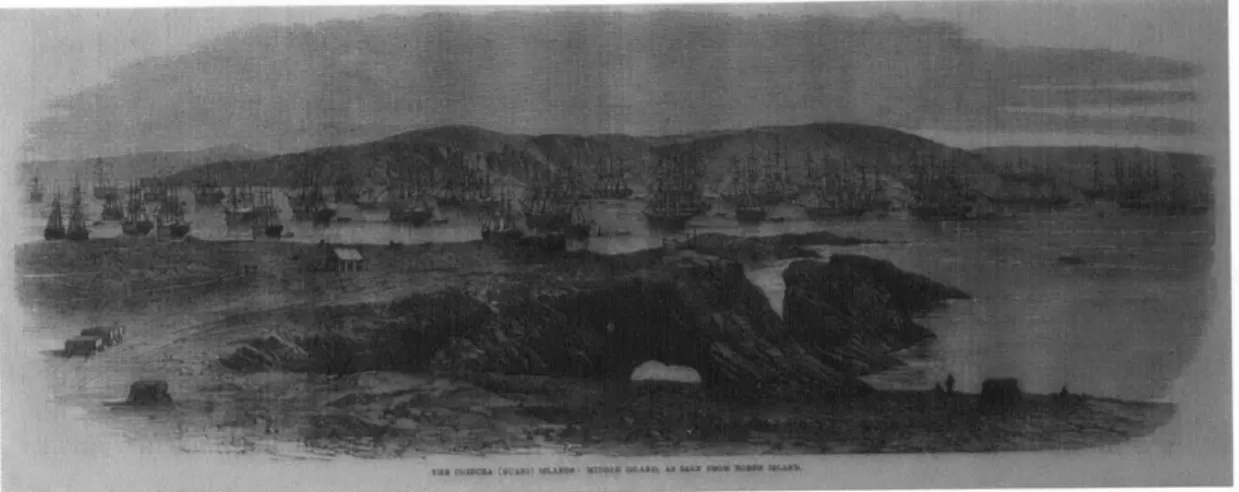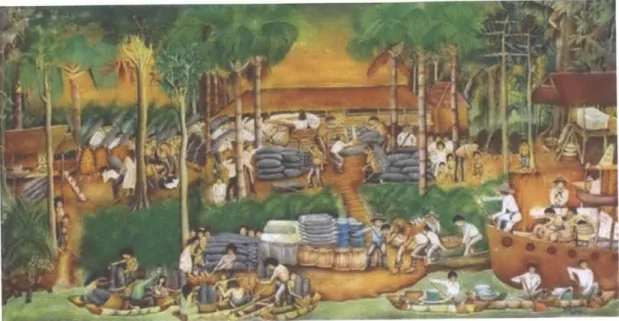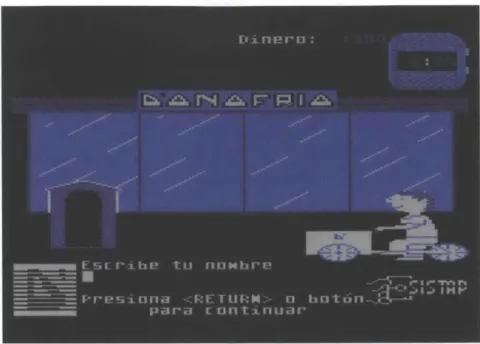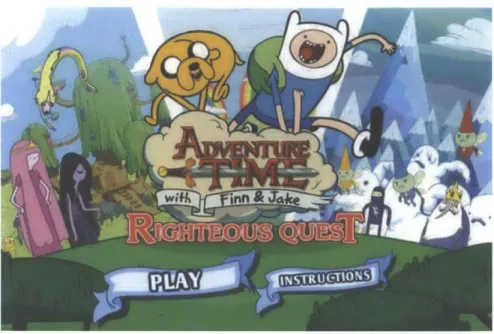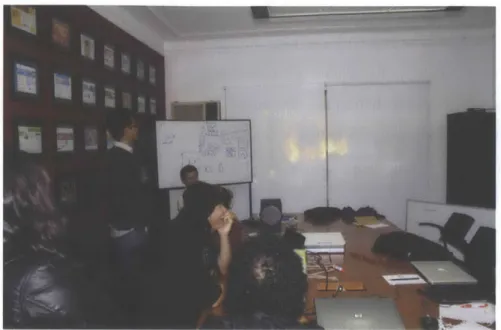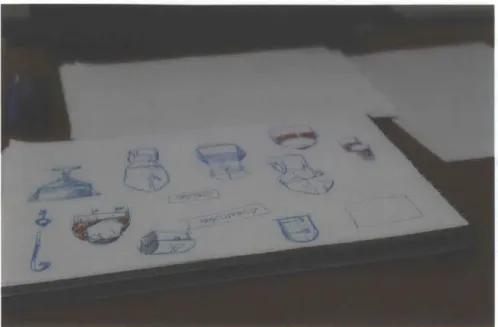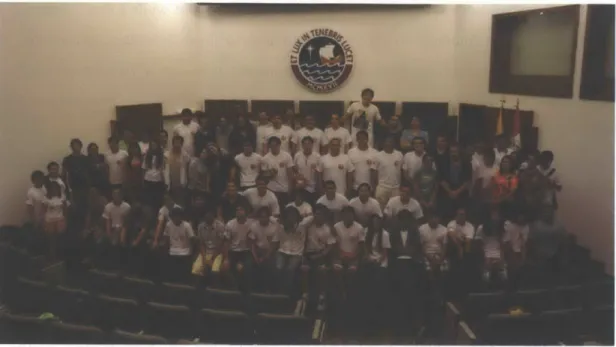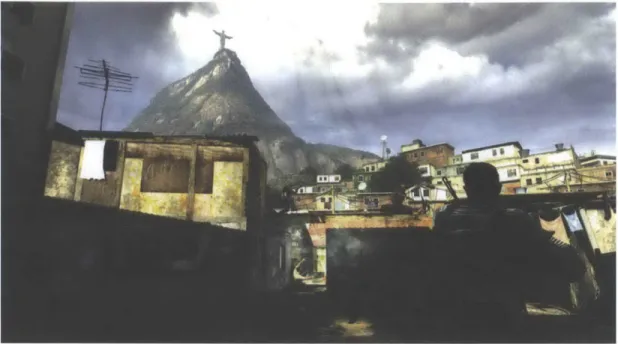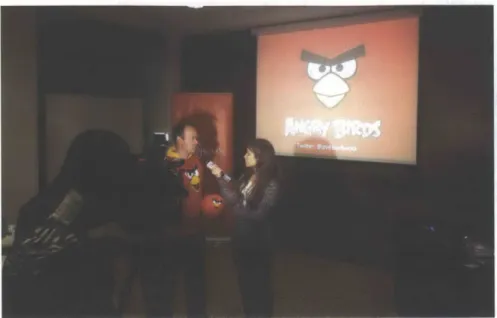Developing Game Worlds:
Gaming, Technology, and Innovation in Peru
by
Eduardo Marisca Alvarez
B.A., Pontifical Catholic University of Peru (2008)
Submitted to the Department of Comparative Media Studies/Writing
in partial fulfillment of the requirements for the degree of
Master of Science in Comparative Media Studies
at the
MASSACHUSETTS INSTITUTE OF TECHNOLOGY
June 2014
@Eduardo
Marisca Alvarez, 2014.
The author hereby grants to MIT permission to reproduce and to
distribute publicly paper and electronic copies of this thesis document
in whole or in part in any medium now known or hereafter created.
Author
....
Signature redacted
.
...
n
Department of Comparative Media Studies/Writing
Certified by ...
Signature redacted
May 9, 2014
Accepted by ...
T.L. Taylor
Associate Professor of Comparative Media
Thesis upervisor
Signature
redacted
.
Heather Hendershot
Director of Graduate Studies, CMS
Professor of Comparative Media
MASSACHUSETTS INST1 OF TECHNOLOGY
MAY 2
7
2014
Developing Game Worlds:
Gaming, Technology, and Innovation in Peru
by
Eduardo Marisca Alvarez
Submitted to the Department of Comparative Media Studies/Writing on May 9, 2014, in partial fulfillment of the
requirements for the degree of
Master of Science in Comparative Media Studies
Abstract
In this work, I've documented the origins, growth and structure of the Peruvian video game industry.
Because of its underground origins, the Peruvian game industry provides an alter-native, more organic gateway to developing technology industries than forms of the "technological sublime" that have been recurrent over Peruvian technological history. Driven by creative rather than commercial objectives, people interested in game devel-opment figure out ways to get around gaps in existing training options to acquire the interdisciplinary skills they need to create games - setting up alternative infrastruc-tures to connect to each other, share information, and set up collaborations. Peruvian developers are also experimenting with ways to gain access to global networks and markets, which affects their design decisions and how they present themselves to peers and customers around the world. Games designed to present local cultural elements for international audiences - which I've called "borderland games" - have become sites where tension around self-presentation gets played out.
Game studios are experimenting with various configurations of business practices, figuring out empirically what arrangements put them on the better path to engage international partners and secure creative and financial sustainability. Studios are collaborating with each other to address structural barriers affecting the industry as a whole, which is putting them in a stronger position to engage government agencies and gain support to address structural issues.
This relatively unknown industry has been able to introduce complex skills and work around structural gaps and obstacles to create the foundations for a potentially viable technology and creative industry. How, exactly, the industry will develop remains to be seen, but its evolution can provide interesting lessons for the emergence of digital creative industries in developing economies.
Thesis Supervisor: T.L. Taylor
Acknowledgments
The acknowledgements section for this thesis could easily run longer than the thesis itself. Over the course of several months, I've had the good fortune to receive help and support from multiple people, in Cambridge, Lima, and elsewhere. People have been kind enough to let me into their homes and workplaces, and to sit with me for countless hours of conversation.
On the Lima side, I'm very thankful for the support and collaboration from ev-eryone in the local game development industry, and very especially from Luis Wong, Juan Jose Miranda, Sol Samaniego, and the team at The Boneless - Renzo Guido, Joan Odicio, Max Pefia, and Aldo Quispe - who provided me not only with excel-lent information, but also with access to many sites of research and social networks crucial to my research. I was also fortunate enough to enlist collaboration from mul-tiple people in the industry or related institutions who provided me with data or sat down with me for interviews: Lobsang Alvites, Michael Barclay, Oscar Choquecota, Phillip Chu, Christian Flores, Adam Johnson, Felix Lossio, Luciana Mendoza, Javier Mufnoz, Giacomo Preciado, Lorena Sanchez, Renzo Sanchez, Chiemi Tsukazan, Pierre Van Doorne, Maite Vizcarra.
On the Cambridge side, I could not have finished this project without the support of my thesis advisor at MIT, T.L. Taylor, whose ongoing feedback and insight proved extremely valuable to the end result. I'm also extremely grateful for the feedback from my thesis committee member, Ian Condry, whose Creative Communities Initiative turned into a very fitting roof under which to explore many of the themes I became interested in. Over the last few months, I've also been extremely fortunate to receive support and feedback from Scot Osterweil, creative director at the MIT Education Arcade, where I was a research assistant during my time at MIT. This research project also received early and crucial support from Jim Paradis, who helped me articulate what it would look like and provided crucial resources that allowed me to pursue fieldwork in Lima. Additionally, I'm grateful to the International Game Developer Association, whose IGDA Scholarship program allowed me to attend the 2014 Game
Developer Conference in San Francisco, California.
I'm also very much indebted to the members of my cohort in the MIT Compar-ative Media Studies program, the class of 2014, who observed this project evolve over the course of two years and had to endure pitches and presentations one too many times: Denise Cheng, Rodrigo Davies, Erica Deahl, Julie Fischer, Alexandre Gongalves, Jason Lipshin and Lingyuxiu Zhong. Members of the CMS class of 2013 (Amar Boghani, Katie Edgerton, Ayse Gursoy, Rogelio L6pez, Chris Peterson, Molly Sauter, Steve Schirra, Abe Stein, Huan Sun, Jia Zhang) were also helpful in providing guidance and moral support at the early stages of this project, as were members of the class of 2015 (Liam Andrew, Chelsea Barabas, Heather Craig, Suruchi Dumpawar, Sean Flynn, Desi Gonzalez, Jesse Sell, Erik Stayton, Ainsley Sutherland, Yu Wang) in reading and reviewing sections of this work in various contexts. All of them have helped me think through the issues at stake in my research during long brainstorming sessions at the MIT Muddy Charles Pub, where a significant share of this work was written.
I've received comments and feedback from multiple people on various sections of this work. For chapter two, I received feedback from William Uricchio, professor in the MIT program in Comparative Media Studies. For chapter five I received feedback from Casey O'Donnell, assistant professor in the Department of Telecommunication, Information Studies and Media at Michigan State University. And chapter six re-ceived feedback from Alberto Vergara, visiting fellow at the Weatherhead Center for International Affairs at Harvard University.
The contributions from all these people have made my arguments much stronger, and considerably more interesting. Any mistakes or inaccuracies, of course, remain entirely my own.
Special thanks go out to my family, who've supported and encouraged me for many years, even when they didn't fully understand just exactly what it was they were supporting or encouraging.
And finally, to Clara, for whom the fact that this work is done means I can finally return home.
Contents
List of Figures 9
List of Tables 11
1 Introduction 13
1.1 Mapping the Global Game Industry . . . . 17
1.2 Creative Communities in the Global Periphery . . . . 20
1.3 The Challenge of Creating Creative Industries . . . . 23
1.4 Following Games Through Society . . . . 26
2 Reconstructing a Technological History 33 2.1 Peru 2.0 . . . . 35
2.2 Pursuing the Technological Sublime . . . . 41
2.3 The Promise of a Nation . . . . 44
2.4 Gaming as a Technological Counter-Narrative . . . . 52
2.5 Local Area Networks . . . . 61
3 How to Become a Worldbuilder 71 3.1 Gaining Access . . . . 74
3.2 Opening the Black Box of Game Development . . . . 76
3.3 Gaining Experience Points . . . . 86
3.4 Learning as an Ancillary Industry . . . . 96
4 Not All Peripheries Are Created Equal 4.1 "If Finland can do it, so can we" ...
4.2 The Making of a "Native Product" . . . ..
4.3 Games as Sites of Cultural Negotiation . . . . 4.4 Reverse-Engineering Transnationalism . . . . 5 Playful Ventures
5.1 Starting Up . . . .
5.2 Funny Business . . . .
5.3 Software Industry, Culture Industry, Media Industry 5.4 Stepping Out Of The Shadows . . . .
5.5 "Education, Entertainment, Entrepreneurship" . .
6 The Entrepreneurial Republic
6.1 The Game of Politics . . . . 6.2 Startup Nation . . . .
6.3 Innovation "Ecosystems" . . . ..
6.4 "Export Quality" . . . .. 6.5 Gaming the Entrepreneurial Republic . . . .
7 Conclusions: A Perfect Storm
7.1 Too Small to Fail . . . .
7.2 Creative Communities and Economic Complexity . .
7.3 A New Socio-Technical Contract . . . .
7.4 Game Over . . . . Bibliography 109 . . . . 113 . . . . 119 . . . . 130 . . . . 143 147 150 158 167 170 179 183 186 194 200 204 209 211 213 218 222 226 229
List of Figures
2-1 A photograph of ship traffic around the guano islands of Chincha, 1863 45
2-2 Brus Rubio. La explotacidn del caucho en Pucaurquillo (The
Exploita-tion of Rubber in Pucaurquillo) . . . . 50
2-3 A screenshot from Aventuras D'Onqfrio . . . . 53
2-4 A screenshot of Fdtbol Excitante . . . . 58
2-5 Opening screenshot for Adventure Time: Righteous Quest . . . . 69
3-1 Pitching game ideas at the beginning of a small game jam. . . . . 78
3-2 Early character illustrations for Conclave. . . . . 84
3-3 Group photo of participants at the 2014 Global Game Jam in Lima . 96 4-1 Entering the favela in the Takedown scenario in Call of Duty: Modern W arfare 2 . . . 111
4-2 Peter Vesterbacka, Chief Marketing Officer for Rovio, being inter-viewed for Peruvian television. . . . . 114
4-3 Rovio people presenting their history to a classroom packed with de-velopers in Lim a. . . . . 117
4-4 Flappy Bird's austere and controversial interface . . . . 120
4-5 An example of Chulucanas ceramics . . . . 123
4-6 Marca Peru", the Peru country brand developed by PromPerd. . . . . 127
4-7 Screenshot of Palomilla Hunter . . . . 131
4-8 Artwork for Inka Madness . . . . 133
4-10 Artwork for Kilka Card Gods . . . . 136
4-11 Screenshot of Kilka Card Gods . . . . 137
4-12 Screenshot of Guacamelee! . . . . 139
4-13 Vendedora de alcatraces by Mexican artist Diego Rivera . . . . 141
5-1 Setting up the Peruvian country booth at the GDC show floor. . . . . 173
5-2 Official PromPeru brocuhure promoting Peru as a "creative country". 176 6-1 The video games workshop at the Peru Service Summit, before presen-tations got started. . . . . 188
List of Tables
3.1 A summary of the roles involved in game development and distribution 82 5.1 A summary of business models for video game studios in Peru . . . . 166 6.1 Game studios vs population size in Latin America . . . . 204
1
Introduction
"You mean there's video game developers in Peru?"
This was the question I got used to hearing whenever I told people I was doing research on the video game industry in Peru - a strange mixture of disbelief and contempt. Peru is known around the world for many quaint and curious things, and in recent years, the story of its recent economic boom has been a hallmark of business magazines all over. But it is not an economy or a society known for its highly technological production. To make the claim that there was an emerging video game industry in the country was therefore not only counter-intuitive, but to many people sounded almost delusional.
And yet, over the course of many months of research, I uncovered and followed a growing industry in a highly unlikely place, and began mapping an energetic commu-nity that was driven by a powerful creative energy. As it turned out, not only did the gaming industry in Peru exist, but it had been around for over two decades, largely operating beneath the radar. As I started untangling the narrative thread of the game industry in Peru, I found myself following people, organisations, and games around through multiple timeframes, contexts, and geographical locations. I've seen game development studios come together and fall apart, projects push through and fade away, and developers finding and losing their way within a dynamic and fast-changing community.
of previously disconnected initiatives are beginning to acknowledge each other and consolidate into a sector, more self-aware of its own identity, challenges and position in the global gaming industry. My challenge in researching the industry and its network of stakeholders and practices has been to determine how this specific moment has come about, and perhaps even more importantly, whether this transition moment represents a jumping off point towards the next stage in the industry's evolution, or rather just a fluke in the normal chain of events. And whether this next big thing is actually attainable is a key matter not only to game creators, but to technology practitioners in general, as it represents the test on whether the Peruvian economy can seed, sustain and grow various forms of technology-based industries.
In what follows, I will argue that not only does the Peruvian video game industry exist, but it has also managed to grow consistently over the last few years, despite its relative invisibility and a series of structural issues that limits its growth. I will also make the case that the growth of the industry has been primarily driven by transactions in social capital as opposed to financial capital, as people who are part of this industry are driven by creative desires rather than potential financial returns when deciding they want to be a part of the production of this medium. The Peruvian game industry has been able to come together and grow because people were driven
by a creative passion to take on more risk than they would have had they been making
strictly rational decisions, in the economic sense. While the costs they bear and the risk they assume are perhaps higher than they should be, they make up for it through the increased learning and creative returns they find in engaging with an emerging technological practice that connects them to global communities of makers.
The world I was able to uncover in my research turned out to be extremely rich and diverse, full of creative people bursting with energy and drive to transform it into new creative products. What they didn't know, they learnt, and what they did know, they shared. Of course, it was not without issues and complications, which I'll attempt to unpack in the following chapters, trying to voice the wants and concerns of the many people who eagerly agreed to talk to me and tell me about their work.
game industry and surrounding game development community as a coherent whole,
I want to make the case for three core ideas that I found most salient after spending
a lot of time with video game developers in Peru.
The first is the story of the Peruvian game industry itself, and how it has man-aged to slowly and organically come together over the last couple decades despite systematic lack of support and considerable prejudice from multiple actors. The game industry has been able to push forward through the establishment of a series of alternative infrastructures that facilitate its operations, and by building heavily on tight social networks that transact in social capital everything they're incapable of ac-quiring through material means. The story of the industry, and the loosely-structured community that surrounds it, is a collection of stories from primarily young people who've grown up playing games and feel strong emotional connections to them - and then, at some point, decide they want to express themselves through this medium. It is their creativity that, in most cases, drives them to adopt a risky decision such as wanting to make a living out of developing a technology and a medium that is vir-tually unknown in their local context. Over time, these networks have grown tighter and have managed to build some nascent institutions that formalise and provide con-tinuity to many of the informal arrangements on which the industry was built -providing a critical platform for old and new actors to achieve a sustainable practice
and pursue more ambitious creative objectives, reaching out to international markets and having their games downloaded by players around the world.
The second core idea is not only how this industry was possible at all, but how meaningful it is that it's there. From an economic point of view, there should be no Peruvian video game industry: the cost of getting the operation in place is far larger than the potential financial returns it can get. And the larger share of that cost is re-lated to skill acquisition: the game industry depends on a number of interdisciplinary skill sets that are simply not popular enough in the local economy to provide steady streams of qualified talent. In other words: the building blocks required to have a sustainable game industry are just not in place. And yet, there it is. By exploring the practice of game development in Peru through an ethnographic approach I've been
able to uncover networks of learning and production that would otherwise remain in-visible, and then try to reconstruct the reasons why this anomaly has been possible. The Peruvian game industry exists because it is not driven primarily by financial or commercial motives. People in the industry are consistently not looking for profits, but rather for sustainability. But their activities are nonetheless still economically significant, and still have a larger impact in their ecosystem: the interdisciplinary skills related to game development that are being introduced into an economy
-related to software development, project management, computer animation, and so on - become available not only to the development of games, but to other creative industries as well. Because of this, we can consider the possibilities this sort of cre-ative communities - loose assemblages of people brought together by their shared interest in a creative practice - offer for the emergence of new creative industries,
especially in the context of developing economies.
The third core idea that I've surfaced through this research is related to the sin-gular relationship with technology that people in the Peruvian game industry are developing, both for the context of a developing economy lacking a significant tech-nology base, and as compared to other creative industries. There's a recurring pat-tern in Peruvian technological history of treating technologies as black boxes that are deployed at varying scales, with the expectation that they will generate radical transformations in social and cultural conditions and bring about a "modern" na-tion. The game development community breaks with that tradition: it has been built from the ground up, without any major backing project or implementation, and has grown out of individuals reverse engineering forms of both technology and process. The result is that members of the game development community have a much more straightforward, informed, and organic relationship to technology: without everyone being a hacker or a coder, people come to understand what technologies can do for them, and how they fit into their everyday lives. This has become to me an inter-esting template to rethink how we understand the deployment of new technologies in developing economies: rather than push for radical transformations coming from black boxes, we need to think about the entanglements between local cultures and
practices, social networks and institutions, and technologies and processes. The re-sult is, perhaps, less sexy than the imaginary possibilities of airdropping shiny toys into remote locations, but if the Peruvian game industry is any indication, it can be more sustainable and have a stronger impact not only in people's relationship with technology - but also how they relate to larger, opaque systems that affect their daily lives.
The chapters that follow will provide a number of stories and accounts that have led me to these high-level ideas. But before jumping into the details and layers of all of these, I want to begin by narrowing down some of the background information that's available related to these aspects: by focusing on existing research about games and the game industry, on creative communities in "peripheral" locations and how they engage global networks, and on the development of technologies industries, especially in developing economies. This will both help narrow down the field within which this research is situated, and to provide relevant connections to theory and previous research that have informed this work. I will conclude this introduction by providing some notes on the methodological approach I've followed, as well as an outline of the chapters that follow.
1.1
Mapping the Global Game Industry
As recently as 2002, research suggested that the Latin American gaming industry was simply not possible beyond a cheap labour model of building consoles in free trade zones (Lugo et al. , 2002). Yet over a decade later, there are meaningful pockets of game creation activity popping up throughout the region, which are starting to interact with each other. A loosely coupled game development community has started to consolidate as an actual industry and to think about the role it can adopt within the regional and the global industries.
This is to a large extent a result of the changing landscape of the game industry globally. As technological advances have made it possible to increase the computa-tional power and connectivity of smaller devices, gaming has gone from being bound
to specific spaces to becoming an experience that can be had anytime and anywhere. This, in turn, has resulted in the emergence of new player profiles, such as the so-called "casual gamer" (Juul, 2012). Especially as access to game development has widened and independent development has become a viable option, there's a growing number of people who are expressing all sorts of visions through games (Anthropy, 2012) - personal memories and anxieties, political messages, cultural critiques, and so on. Games are becoming an established medium for cultural expression, which is driven by incentives that need not be economic. This is also happening through the creative and critical re-appropriation of existing commercial video games through newly-available modding tools and software development kits (SDKs) developers are making available to their audiences to increase user engagement and capitalise on user-generated content (Sotamaa, 2010; Postigo, 2007; Newman, 2005; Yee, 2006).
These technical changes have resulted in industrial and organisational reconfigura-tions, as new forms of video game studios become viable and new means for engaging audiences become accessible. The last few years have seen significant growth from the independent side of the video game industry, who are now experimenting with new business models and forms of monetisation (Zackariasson & Wilson, 2010, 2013). As games continue to grow in popularity (Entertainment Software Association, 2013) and gaming experiences become more pervasive and popular, new options are becom-ing available for indie developers and studios in terms of securbecom-ing fundbecom-ing for projects
and companies (Della Roca, 2014; Lasky, 2014; Guillaud et al. , 2013).
The game industry has changed significantly over the past few years - and so has the practice of game development itself. While game development began as a mostly experimental affair where solutions to computational problems had to be hacked together as cleanly as possible so as to not break a player's sense of immersion and interactivity (Montfort & Bogost, 2009), over time the industry has stabilised enough that a number of roles and processes have come to be expected of any typical development team (Bates, 2004; Moore, 2007; Salen & Zimmerman, 2004) - even if individual teams have a lot of latitude in terms of deciding how they want to prioritise and allocate the various components in their production process.
How teams are designed, roles allocated, and decisions made, is also heavily in-fluenced by a studio's alignment with broader media practices and understanding of the nature of the game industry. Different national traditions have had different evo-lutionary trajectories for their respective game industries (Izushi & Aoyama, 2006), building them out of pre-existing culture, media, or technology industries. While there tends to be a closer affiliation between the game industry and software de-velopment because of the importance of the software components that make video games work, the industry cannot really be reduced to being an offshoot of software development (O'Donnell, 2012b). There are broader things at stake when creating game worlds, including issues of cross-cultural communication (Carlson & Corliss, 2011) and identity representation (Leonard, 2006) - issues that are not necessarily foregrounded when developing non-entertainment software (Eischen, 2003) - though there are multiple examples of software analysis and design that do push for this
foregrounding (Harrell, 2013; Manovich, 2013).
While the game industry is made up of a number of globally circulating prac-tices, it necessarily operates on an everyday basis as a local affair, and there has been some research on the operations of various specific local and national indus-tries. This prior research has included studies on locations that are considered to be more central within the realm of game development, such as the game industry in the United States (O'Donnell, 2012a), Canada (Dyer-Witheford & Sharman, 2005), Japan (Aoyama & Izushi, 2003). Other studies have performed a more comparative analysis between different national industries such as those of Ireland and the United Kingdom (Kerr, 2012) or across Europe (Preston & Kerr, 2001), or between the in-dustries in the United States and India (O'Donnell, 2014, forthcoming), or focused on less central locations, such as the Swedish game industry (Sandqvist, 2012) or Korea's online gaming industry (Jin, 2010). For the Latin American region, there is a remarkable gap in existing research, with little information available about vari-ous national game development industries or player communities other than informal sources. It is worth singling out as an exception the work of Maria Teresa Quiroz and Ana Rosa Tealdo, who developed and published a study on gameplay impact on
Pe-ruvian school kids back in 1996, in an attempt to contextualise growing moral panics with actual data and scholarship (Quiroz & Tealdo, 1996). There is some additional research available that analyses the presentation of Latin American reality within the context of game worlds (Penix-Tadsen, 2013) and formulates a number of categories under which typical portrayals are presented.
There are two additional threads of previous work worth pointing out. One is the interpretation of the video game industry as global system of culture and capi-tal circulation (Dyer-Witheford & De Peuter, 2009), trying to develop a big-picture understanding of the network of inputs and outputs connected to the video game industry. In contrast, there are various researchers who have focused instead on the individual practices of video game developers, providing not only a local understand-ing of their actions but also a highly individualised and detailed account of what game development looks like. These readings include both analysis of how video game developers make their decisions (O'Donnell, 2009) and how production deci-sions are made at the creative and commercial levels (Tschang, 2007; Zackariasson
et al. , 2006; Cohendet & Simon, 2007).
These multiple understandings of the various layers of the game industry have configured the work I've done with the Peruvian game industry, trying to contextualise it both within the realm of processes that make up the global game industry, but also helping delineate what the cultural and operational specificities are to game developers operating in Peru, and more specifically, the city of Lima. Following that thread, developing a more nuanced understanding of how geographies come into play when thinking about technology and creative industries around the world is especially important to unravel how Peruvian producers are connected to transnational networks of production and consumption.
1.2
Creative Communities in the Global Periphery
In my research, there have been four major studies I've found especially important both thematically and methodologically to anchor and contextualise my own process
and data. These have been especially relevant to me because they also work around issues of globalisation from the point of view of more or less "peripheral" locations and specific creative industries within them.
One example of such research is the work on the Nigerian film industry by Brian Larkin, which focuses on how and why the industry came together in close interac-tion with the country's colonial and cultural history (Larkin, 2008). Larkin's analysis sheds some light on the range of effects technology had as a spectacle of power and progress during colonial rule, something that is also relevant to the interpretation of Peruvian technological history: Larkin speaks of a "colonial sublime" formulation where technology and infrastructure became placeholders for Nigeria's emergence as a modern, global nation, something that resonates quite clearly with the Peruvian his-torical dependence on foreign financial and cultural capital to design and implement large-scale nation-building projects. For the Nigerian film industry to come together, infrastructures - both social and technical - became an especially important issue that enabled or disabled what a creative community could produce and distribute,
an element that is also resonant of challenges face by the Peruvian game industry. Another example is the work done by Ian Condry on the Japanese anime industry, which maps its origins as a loosely-structured creative communities and its struggles to become a globally-accessible commodity that remains authentic and local in its production (Condry, 2013). The Japanese anime industry had to negotiate its way through multiple issues before consolidating as an important reference point for an-imation around the world, and in many cases what drove groups and individuals through this negotiation was the pursuit of primarily creative objectives: despite its popularity as an animation form, Japanese anime has not become a financially-driven hit production machine, but rather a platform for animators in Japan to explore cre-ative possibilities under a sustainable model. This industry is an example of how creative communities can become organised over time and articulated as productive sectors within the creative industries, building on the organic incentives creators have to share their visions with an audience.
de Janeiro, Brazil, was also especially helpful both because of the thematic and ge-ographical proximity (Takhteyev, 2012). Many of the same issues and questions Takhteyev mentions from working with carioca software developers resonated heavily with things I ran into myself in the Peruvian game industry, especially when related to the understanding developers have of their own practice within a larger global network of practitioners. Just as with Peru, Brazil is an emerging Latin American country that has long been struggling with gaining access to modernity and reinter-preting itself as a modern, globalised nation. Its software development industry is itself struggling to carve out a position for itself and negotiating an identity that's split between being anchored in a very much local reality while working on intangible products that are circulated around the world.
Finally, a study by Anita Chan published shortly before I was finishing this re-search was especially helpful, as not only did it deal with the issues of authenticity in local and global technology and creative industries, but also because it dealt specif-ically with Peru and government efforts over the last decade to create innovative intellectual property regimes that contribute to the establishment of local creative industries (Chan, 2013). Chan's account was helpful in that it clearly articulated the analogue with the digital and evidenced the complexity of managing these new creative industries in ways that remain authentic, sustainable, and respectful of local social networks and institutions.
These four studies also provided very helpful methodological framings to orient the qualitative work I was interested in developing with game creators in Lima. And there is additional research roughly located between the areas of creative industries and global/local relations that has been especially helpful in unpacking many of the issues I found during my time in Lima. One of the core issues that gets played out in various ways is, for example, the issue of authenticity (Peterson, 2005) and how it affects design decisions and the presentation of products and ideas to global audiences
- something that was especially relevant when developing the ideas on borderland
games. In a country such as Peru, the social construction of authenticity is clearly instantiated in all its complexity in the tourism industry, which becomes a relevant
marker for understanding the global packaging of a cultural history (MacCannell,
1999). Beyond this specific example, there is a wealth of research that theorizes on the
various issues affecting local cultures and communities in their global interactions and how information flows are transforming conceptions of both the local and the global (Moore, 2004; Appadurai, 1990, 2010) and creating systems that are simultaneously
both and none (Vertovec, 1999; Kearney, 1995; Fischer, 2007; Olwig, 2003).
1.3
The Challenge of Creating Creative Industries
A third category of relevance to briefly unpack before moving forward concerns the
knowledge infrastructures that support an economy, and the connection between skills and industries. The work on economic complexity by Cesar Hidalgo and the Macro Connections research group at the MIT Media Lab together with Ricardo Hausmann from the Harvard Kennedy School is especially helpful to illustrate this connection
(Hausmann & Hidalgo, 2011a,b; Hidalgo & Hausmann, 2008, 2009; Bahar et al. ,
2012). The perspective of economic complexity looks at how products are connected to each other, understanding products in terms of the skills required to produce them. Some products then become more complex than others because they require a larger number of skills; economies become more complex because they contain within them the skills required to produce larger numbers of products. More complex products become more valuable because fewer countries have the total number of skills required to produce them, while less complex products become contested areas where many countries compete over who can provide the lowest price. Some products' skill components are shared with other products, and therefore, countries able to produce one will be closer to producing the other than countries producing none of them. Economies then become networked structures, where command over various skills provides a foothold into the creation of new industries and the availability of new products. This also accounts for why some countries are able to innovate and expand into other industries faster: as the available pool of skills grows, the marginal cost
of introducing the additional required skills becomes lower1
. Over time, this implies that newcomer advantages compound, and the difficulty and cost for latecomers to catch up keeps rising exponentially, rather than linearly.
To compensate for this, policy makers usually make the argument for the inten-tional building of clusters following Michael Porter's well-known analysis of the ben-efits of aggregating the needs of multiple firms in the same industry within one same location (Porter, 1998) - the proximity of these firms creates formal and informal "knowledge spillovers" from people in the industry being able to easily collaborate and share information, increasing the opportunities for inter-firm collaboration, or companies working together for specific projects (Ahuja, 2000; Powell et al. , 1996).
But the investments required for building these clusters tends to be very high, without any assurances that returns on investment will match expectations (Huber, 2011).
To a large extent, these investments are oriented towards the introduction of new skills into an economy - just as products can be interpreted as combinations of skills following Hausmann and Hidalgo's work, new products can be interpreted as new combinations of skills. Investments in education by public and private parties then become especially relevant, and available reports show increased access to education across the Latin American region (Blom & Murakami, 2008). But there seems to be a misalignment between the skills being introduced and the skills these economies need to move in more strategic directions in terms of technology development and innovation (Bassi et al. , 2012), as there continues to be a lack for intermediary spaces that enable academic research and translate it into commercial projects and ventures
(Ismodes Casc6n, 2006).
Skill acquisition then becomes one of the hardest challenges for developing economies, as the cost is high and often trumps the incentives an economy might have for it
-especially as it is not simply a matter of enabling a teaching infrastructure for it, but rather an operational matrix for putting it in practice (Arrow, 1962). Economic
'For example, despite being very different activities, the process of manufacturing cars shares some subset of skills with the process of manufacturing planes. A country that manufactures cars will be closer in complexity, time and resources to manufacturing planes than a country that does not manufacture cars.
analysis has also suggested that just having the requisite skill base is not enough, but rather the surrounding ecosystem for the creation of new ventures is also an important factor (Schumpeter, 1949), as it encourages risk-taking and innovative combinations of skills and ideas - not all of which will ultimately become sustainable.
Access to new technologies of communication and coordination has been shown to reduce the transaction costs for groups and organisations, thereby indirectly reducing the risk for new ventures to form and expanding the diversity of actors that can undertake all sorts of projects (Benkler, 2006, 2002). Not only that, but research has also shown how especially young people are picking up skills in various areas through informal exposure to technologies and learning communities, without having to necessarily go through more formalised training programs (Jenkins et al. , 2009;
Ito, 2009). In combination, these two research threads - lowered transaction costs for groups and organisations, plus the opportunity for people to pick up new skills through informal work in project settings - show potential for these largely informal, unstructured environments to become the foundation for new skill combinations and new creative projects to be created within an economy, without the need for massive and carefully allocated public investments. This becomes especially more interesting in an economy such as the Peruvian one, where one the one hand, a sizeable share of the economy remains primarily informal (Durand, 2007), and on the other hand, the state's capacity to quickly respond and adapt to changing necessities has been proven ineffective as public services became overwhelmed by surges in demand and cuts in resources over the last few decades (Matos Mar, 2012).
The urgency regarding this economic reconfiguration is also backed by two further threads. First, it is important to consider that the work and the learning being done in many of this informal settings is going entirely unrecognised, often simply because there are no specified forms of measurement that are looking out for them -something that has become a recurring problem when trying to measure innovation happening inside and outside firms (Brynjolfsson & Saunders, 2010). This forced invisibility speaks to the need for the redesign of our observational techniques when it comes to innovation and creativity to be more attuned to things happening informally.
But secondly, it is also important to consider that the accelerated rate of innovation within technology industries in the last few years is forcing the reconfiguration of many interlocking systems (Brynjolfsson & McAfee, 2012) around the economy, business practices, and labour regulations. The implications in this context for the Peruvian economy, and for the Peruvian game industry, become especially significant: on the one hand, the Peruvian economy should have a much higher sense of urgency about increasing its complexity so it can become more resilient to impending technologically-driven shifts in production and market organisation; on the other hand, informal communities, such as that which became the origin for the local video game industry, offer the potential for less costly and more organic building of new industries and sources of innovation that would otherwise be too costly to implement if done with sufficient diversity.
As I will try to show in the various chapters that follow, the Peruvian game indus-try is providing a template for a new sort of economic and technological engagement that has been driven almost entirely by creative motivations. New skills are being introduced and new technologies being developed even in the absence of significant financial investments, resulting in the consolidation of a small but growing industry that has managed to remain sustainable, as a whole, for over two decades. The op-erations of the game industry in many ways address many of the concerns and issues I've listed here, and it'll be important to consider as we move forward whether this model is sustainable, scalable, and replicable to other potential creative industries.
1.4
Following Games Through Society
The ideas so far establish the basis on which I performed research on the video game development community in Peru - specifically, in the capital city of Lima - in order to develop a better understanding of an emerging industry's prospects, and whether it actually had the potential to become a driver of technological growth and the foundation on top of which other forms of technology development could grow.
various forms of peripheral innovation, putting together various forms of alternative infrastructures to overcome the structural obstacles impeding its growth and the pursuit of its creative objectives.
I've attempted to capture the realm of diverse practices, large and small, making up an emerging industry, which would otherwise probably remain invisible to many outsiders (Geertz, 1977). I've been especially interested in trying to reconstruct the various strategies and tactics (De Certeau, 1988) that developers and studios deploy on an everyday basis to move their projects forward, and that are reflected in the multiple creative and business decisions they need to make all the time. Games have not attracted huge amounts of attention nor driven enormous sales numbers, and in many cases, the activities of independent communities and producers have remained entirely invisible because they did not register under any economic indicators. Over the course of my research, I've come to realise that many of the challenges the industry is facing today pertain more to the social structuring and cultural evolution of a com-munity of producers, rather than the business and economic underpinnings of their activities (which is not to say that the latter become unimportant). In other words, while the industry has significant financial and commercial potential, it is rather the creative returns and the social networks that are actually keeping it together.
My research approach has been varied, and resembling what Hugh Gusterson has
termed "polymorphous engagement" (Gusterson, 1997) - following the social dimen-sions of games through its multiple pathways. The bulk of data for this project came from several visits to Lima, Peru, and primarily from a prolonged stay between May and August 2013, when I interviewed people in various roles connected to the industry, visited local game studios, attended industry and community events, and got to play with both finished games and prototypes. My time in Lima was also key to under-standing the context within which the industry is emerging, among a strong rhetoric on the importance of technology and innovation, and a growing movement pushing for innovation ecosystems, entrepreneurship and start-up communities. Being in Lima provided much needed layers of texture and nuance about the environment, and the ways in which technological development and innovation systems intersect with many
other social structures and institutions, including education systems, financing mech-anisms, real estate markets, and even more seemingly disconnected aspects such as transportation networks or public safety. I've attempted to pay close attention not only to the statements and actions of people connected to the industry, but borrow-ing a page from Actor-Network Theory, to the systems, technologies, and non-human actors that are also participating in its practices (Latour, 2005). Following the dis-course of how people talk about technology, and mastering the technical language involved in the production process of games, has therefore been a key component of this project.
There is also a very deliberate reason why I've chosen to pursue an ethnographic approach to my research: because many of the networks and practices I've studied remain mostly invisible to many people, ethnographic techniques proved to be the most appropriate in digging up and shedding light on aspects that otherwise remained invisible (Boellstorff, 2006). Because many of the projects I found are quite small, or non-commercial in nature, many of the existing indicators just fail to register at all the enormous creative activity that's going on under the radar. Adopting a qualitative approach was helpful in uncovering many of these networks and their multiple entanglements with economic, cultural, and institutional systems.
I've also benefited from the proximity to the game development community in and around Boston, Massachusetts, being able to attend various events happening in the area, such as the local edition of the Global Game Jam or the Boston Fes-tival of Independent Games (both in 2013), and to have conversations with people connected to the local industry. Being connected to the network of people and activ-ities associated with the MIT Game Lab was extremely helpful in understanding how patterns, practices, and anxieties were effectively global constructions instantiated in local contexts.
I was also able to attend the 2014 Game Developer Conference in San Francisco,
California2, where I was able to shadow a number of Peruvian developers who had
2I was fortunate enough to receive support for this travel from the International Game Developer Association in the form of the IGDA Scholarship, which provided me with access to the conference and a number of events and mentoring resources which were especially helpful.
travelled for the event. I also visited and learnt more about an official country booth sponsored by a Peruvian government agency within the conference exhibit floor, which represented the single most important form of support the game industry has received to date from the Peruvian government.
Following games through society involved looking at many other things happening simultaneously (Marcus, 1995): looking back at the local history of game develop-ment and placing it in context meant performing some archival research on various sorts of documents, including news articles, photo archives, websites, online forums, "discmags", Facebook groups, and especially playing through games - sometimes having to figure out how to emulate old platforms in order to execute ROM files. The history of game development in Peru has very little documentation to it, and I was able to find traces of games that have probably been lost forever. I've tried to compile as much metadata as I've been able to, at the very least to preserve some record of efforts that happened in the past, with the hope that this process of documentation can become a useful tool for future research3.
In working with game creators and technology practitioners in general, it was im-possible to not have to negotiate my own role in the process as a researcher coming from MIT to document a fairly invisible community. My presence could often be mis-construed as an institutional interest on the industry, or as the arrival of an "expert" capable of providing knowledge and resources. While I had to negotiate expectations continuously, I also found that because of this perception, I could be allowed access to information, people, or interactions that would've otherwise remained invisible to me. I was aware at all times of my obligation not to abuse this opportunity, but I did find a lot of value in turning myself into an active participant in the industry - at times even a champion or an advocate. Providing mentoring and counselling to individuals and groups who sought my opinion gave me some of the most informative interac-tions of the entire project, and it also provided opportunities for me to give back to
3
As a side project to my research, I've began aggregating and curating metadata on as many games and organisations as I've been able to identify throughout the history of Peruvian game development. I've made this (admittedly rough) archive available to anyone who might be interested in pursuing further research through a web interface I developed, available at http://gamedex.lvl.pe.
a community that was already sharing a lot with me. While I'm personally invested in the success of this emerging industry moving forward, I'm also perfectly aware that I'd be serving no one's best interest if I was to avoid unpacking the tensions, contradictions, and issues that sit at the heart of the game industry's practices. I've been as transparent as I've been able to with anyone collaborating with my research and shared insights and perceptions repeatedly, and have attempted to turn what I've interpreted as structural obstacles to the industry's development into design and collaboration opportunities with people in the industry.
It was also important for me to be aware of my ambiguous status as an in-sider/outsider (Kanuha, 2000). Being originally from Lima was extremely helpful in providing me with the knowledge of how to get around the city, figuring out who to talk to, and how institutional arrangements were entangled. It also provided me with a richer sense of just how meaningful transnational networks and information circuits were to local developers. But in many ways I remained an outsider: I was un-familiar with the video game industry or the local game development community, and arriving as a researcher from MIT also contributed to my condition as an "outsider" looking for access.
In what follows, I'll develop these issues and attempt to provide a description of how the Peruvian gaming industry operates, how it understands itself, and what its prospects are moving forward. Chapter two begins with a historical look at Peru-vian game development, and goes back over a century to understand how technology growth has been connected in Peruvian history with boom-and-bust economic cy-cles going all the way back to the nineteenth century. I argue that the country's technological history has been built on a rhetoric of the "technological sublime", or the promise that the nation would come together under the opportunities offered by technology. But in contrast, the Peruvian game industry has not been part of any officially-sanctioned narrative of technological development or the construction of a modern version, and as such, it has been able to establish a relationship with tech-nology on its own terms that has become more sustainable and organic, providing an interesting counter-narrative to the official histories of technology in Peru.
Chapter three looks at how people in the industry (developers, designers, illustra-tors, musicians, and so on) developed their interest for games, how they acquired the skills they needed and went about building careers related to games. In this chap-ter, I pay special attention to the alternative infrastructures set up by developers to bridge the structural gaps stopping or slowing their creative pursuits - because of the lack of local formal options related to game development education, people interested in exploring this practice have put together informal ways through which
they can acquire and perfect the skills they need.
In chapter four, I focus instead on the games being developed by studios in Lima
- specifically, I look at games where cultural presentation is an issue and where local traditions, styles, or themes are incorporated into a game for its presentation to inter-national audiences. I call these games "borderland games", as they become contested areas where issues related to culture, authenticity, and transnational production be-come clearly instantiated. I want to consider the multiple actors and expectations that go into deciding whether and how to make this sort of game, as well as the local industry's conflicting position regarding how they present themselves to international audiences.
Chapter five turns to consider the business practices of established and emerging game studios and how the industry as such is structured, including thinking about business models, distribution channels, audiences, and so on, and the various sources of tension and discussion about where the industry is or should be headed. It also looks at the forms of institutional organisation being developed by local studios, and how they're being effective in engaging government agencies to secure essential forms of support, such as the Peruvian official representation at the 2014 Game Developer Conference.
Finally, chapter six turns the attention to the relationship being forged between the video game industry and various government agencies, and how the Peruvian gov-ernment is creating new channels to engage emerging technology industries through access to various resources. I also want to consider how other governments across the Latin American region are engaging their own national game industries, and how in
the Peruvian case, the game industry is figuring out how to construct a singular and exceptional relationship with government agencies that's very different from that of other local creative industries.
I will conclude by returning to the three core ideas described above, and by going over the current state and future prospects and challenges for the industry, as well as by providing some possible futures and recommendations. I'll attempt to identify opportunities for intervention that might both help consolidate the industry and com-munity further, and accelerate its growth process moving forward. When I first began pursuing this project, I was of the belief that many of the issues and the solutions I'd begin to identify through fieldwork would be related to technological concerns and opportunities - access to newer tools or distribution channels, for example. But as I began to find out, and as I hope I'll be able to convey in what follows, the primary issues affecting this emerging industry are rarely related to technology. In fact, local developers and studios, for most purposes, have roughly the same access to tools and technologies to their peers located around the world. The primary dif-ference, however, lies closer to issues of process and institutions, how production is organised and how projects are managed in order to make them attractive and inter-esting to international audiences and clients. And in order to fully understand how these various layers are connected to each other, we need to consider how technologies have evolved through Peruvian history, and what the place is for video games within Peruvian technological history.
2
Reconstructing a Technological
History
The technological history of Peru has received very little attention. As a developing nation with little internal capacity for the development of new technologies, it has largely been absent as a primary character in most historical and social analysis, though frequently mentioned in passing in various forms - infrastructure projects, industrial capacity, consumer goods, etc. These various forms of technology, as they tend to do, have faded into the background of our understanding of Peruvian history as something that happened outside the realm of agency of the nation.
But just as various forms of technology have become pervasive in everyday life and have also jumped to the forefront of social analysis as an often overlooked presence affecting and shaping behaviour (Latour, 2008), we would probably be well served by re-evaluating the role technologies have played in the coming together of the modern Peruvian republic. Technologies exert various forms of agency by enabling, disabling, connecting, exposing, facilitating, encouraging, or in multiple other ways providing access to social networks and activities. Failing to account for these gives us an incomplete view of how social phenomena are configured, and how our understanding of the world around us is, too, configured by the tools and technologies at our disposal
- and, in turn, these tools and technologies modify our sense of how that world around us can be transformed and reconfigured.
As such, technologies have had an ongoing presence and influence throughout the history of the Peruvian republic - both as objects, and as narrative constructions embodying ideals, desires, and expectations of becoming a modern, independent na-tion. Understood largely as outside forces, they've been often portrayed within these narratives as drivers of progress and promises of change. And they've just as often failed to materialise those promises into lasting, structural transformations.
In what follows, I will examine how various narratives of progress and moder-nity have been constructed over Peruvian republican history around specific forms of technology, often developing hand in hand with a period of economic growth fuelled
by booming exports of some natural resource. I will describe how these narratives
became alternating interpretations of the "technological sublime" - a belief in some form of radical improvement brought about by the introduction of some new tech-nology - and became established as official narratives regarding the country's future and access to a condition of modernity. But I also want to contrast this with the pos-sibility of emerging counter-narratives that offer the pospos-sibility of reinterpreting our collective relationship with technology not from the point of view of official narratives, but rather from the practices of creative communities operating almost invisibly, and even obscured and obstructed by these official narratives.
I will begin by examining how the recent export boom in Peru has been cou-ple with a transformative project connected to the deployment of information and communication technologies (ICTs) in various forms, illustrating the process of at-tempting to articulate a national ideal through technology. I will then provide a more detailed explanation of this concept of the "technological sublime", to then relate it to successive developments taking place over the last 150 years - particularly, the boom in guano exports in the 19th century and the accompanying rush to construct railroad networks across the country, as an especially illustrative case of an official technological narrative - looking for recurring patterns between economic booms and the emergence of discourses and narratives of the technological sublime. I will try to show that these arrangements consistently exhibit a distinct lack of agency from Peruvian society in determining its economic futures, and often result in the
deployment of black box constructions of technology under the promise of access to modernity and, more recently, globalisation. This first section is built primarily on a review of key works by Peruvian historians and social researchers analysing the evolution of the Peruvian nation, as well as the analysis of more recent official doc-umentation from various agencies of the Peruvian government. Moving forward and in contrast, I want to consider in detail a much more recent example of an emerg-ing technological counter-narrative, examinemerg-ing the case of the Peruvian video game industry and how it emerged from an underground culture of hacking and tinkering into a growing industry and community, establishing various alternative infrastruc-tures for learning and play along the way. By examining this case, I want to consider a very different form of relating to emerging technologies occurring within the same geographical space, but treating technologies not as black boxes but rather as flows of knowledge and social relations that can be grasped, analysed, and tinkered with. This section is informed by an analysis of the documentation trail left behind by a video game hacking and development group active between the late 1980s and early 2000s, as well as interviews with current members of the video game industry in Lima, Peru, during a field research trip between May and August 2013. Finally, I will conclude by pointing out some ways in which these contrasting interpretations of the relationship with technology have present-day consequences and implications for technology industries and public policy.
2.1
Peru 2.0
If you were living in Peru towards the end of the 1980s, it would've been perfectly understandable for you to have thought the world was about to end.
Peru transitioned back to democracy in 1980, after twelve years of military rule, in an environment that was quickly becoming terrifying. During the 1980s and early
1990s, the country experienced its most devastating internal conflict in the fight
be-tween terrorist movements, primarily the Shining Path radical communist group, and the Peruvian government and armed forces. The conflict spanned over a decade across
